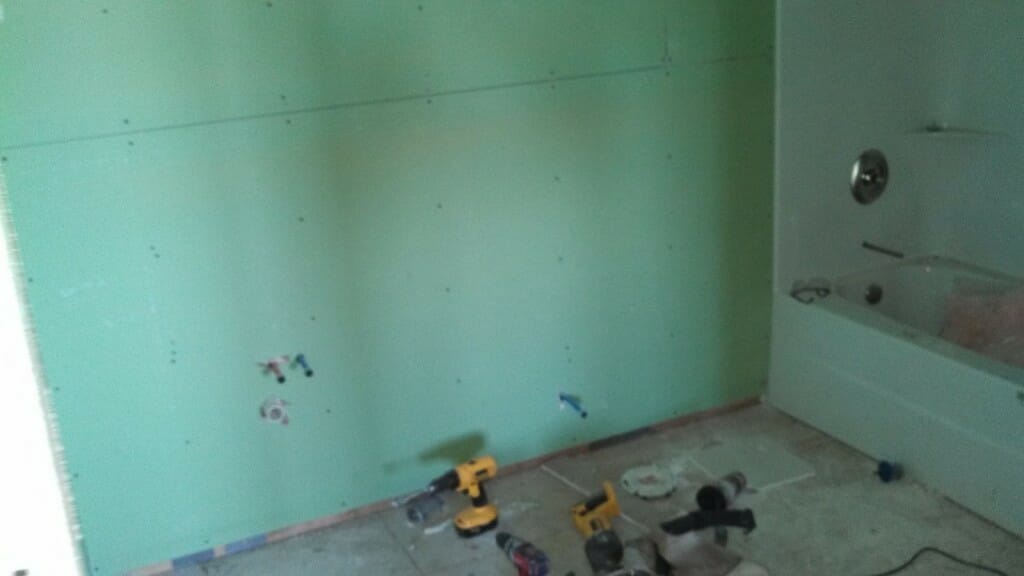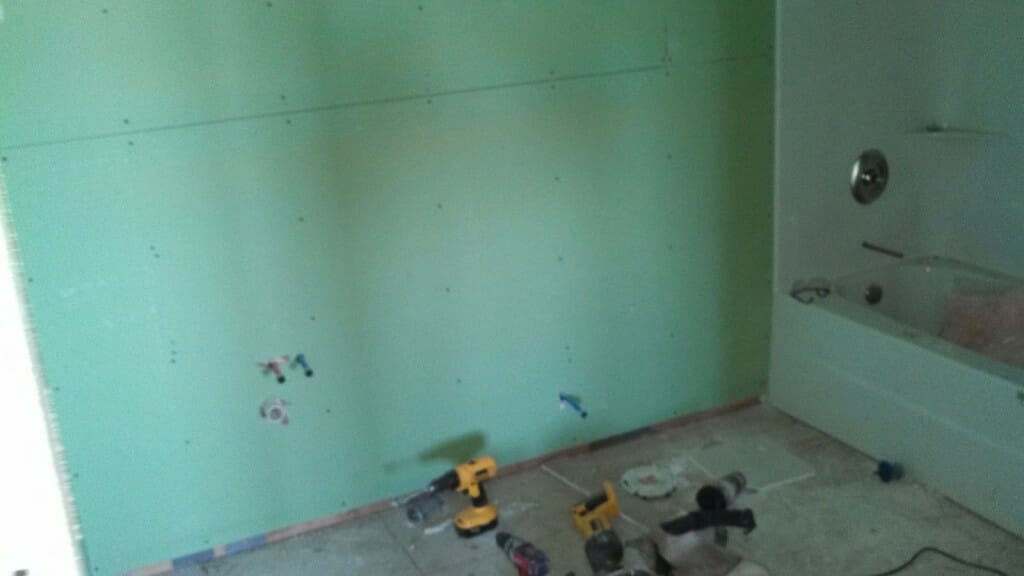Are you doing a home improvement project?
Modernize can pair you with three to four pros in your area, so you can compare options and save time and money.
Whether you’re building a new bathroom in your home, or you’re remodeling a section of your house that’s exposed to humidity, it’s important to know about greenboard and where it’s appropriate to use it. It’s a product that’s good in several sections of the home, and something that you’ll want to use instead of standard gypsum board also known as drywall.
What Is Greenboard?
Greenboard is a water-resistant gypsum board or drywall panel that came out in the 1960s. The product is essentially a more durable gypsum board. It has the same gypsum core that you’ll find on standard drywall all over homes, but it comes with a thicker coating of paper that’s protected by wax for water resistance. The exterior paper has a green tint to it helping to separate it from standard gypsum board, and leading to the product being known by most people as “greenboard.”

Greenboard Is Thicker Than Drywall
While standard drywall comes in ¼” and ½” thicknesses, greenboard is sold in ½” and 5/8″ thicknesses. That’s something that you have to keep in mind if you’re replacing ¼” drywall in your home with greenboard. It’s thicker because of the added wax that’s infused into the material, and also because it has to be. Studies show that greenboard is actually weaker than standard drywall when it gets wet, and the added thickness helps compensate for this. When installed properly, the slightly weaker material isn’t a problem at all and offers superior moisture resistance.
It Is Not Water Proof
Greenboard drywall isn’t designed to line the inside of showers or for use in environments exposed to outdoor weather. It’s the type of material that you want to use down in your basement or another part of your home that’s exposed to more humidity and moisture in the air. Greenboard drywall isn’t water-proof, it simply resists moisture better than the standard gypsum board that’s on most walls in homes around the United States.
Greenboard Is Not Fire Resistant
There is a fire-resistant drywall product known as Type X that’s sold in 5/8″ sheets for use around fireplaces and other high-risk locations in the home. This is completely different than greenboard even though they are both available in the same size. It’s important to realize that greenboard drywall isn’t any more fire resistant than standard drywall is. If you’re looking for a fire-resistant product you’ll have to rely on something like Type X or another solution like Cement Board instead.
Where Should I Install Greenboard?
Greenboard drywall is specifically designed for use in areas of high moisture and humidity, making it an ideal choice for several key locations in a home:
- Bathrooms: Particularly in shower and bathtub areas, where the walls are regularly exposed to moisture and steam.
- Kitchens: Especially near sinks, dishwashers, and cooking areas that may be prone to moisture.
- Basements: Basements can be damp due to their below-ground location, making greenboard a good option for walls in these areas.
- Laundry Rooms: Around washers and dryers, where humidity levels can rise due to the use of these appliances.
While greenboard is moisture-resistant, it is not waterproof. For areas that will be in direct contact with water, such as inside shower walls or floors, a more water-resistant material like cement board is recommended.
Properly Installing Greenboard
Cutting It
Find the Right Contractor for Your Project
Whether you’re ready to begin your project now or need some expert advice, our network of contractors are here to help. With a few simple questions, we’ll find the best local professionals for you
When installing greenboard on the walls of your home, you can install it just like you would standard drywall.
- Cut the pieces to size using a sharp utility knife and a metal straightedge.
- Secure the straightedge in place and score through the outer paper coating using a fresh blade.
- Once the paper is scored, you can snap the board off, changing its overall size to what you need.
Installing it on Walls
- Water-resistant drywall (greenboard) installs similarly to standard drywall.
- Secure it with drywall screws into studs, ensuring screws are just below the surface without piercing the paper coating to maintain strength.
- For multiple rows, stagger greenboard placement to avoid aligning seams, enhancing wall strength despite making tape and mud application more challenging.
Putting it on Ceilings
- Take special care with greenboard drywall on ceilings due to its heavier weight and weaker structure.
- Fasten drywall every 12 inches to prevent sagging, rather than the standard 16 inches.
- Strap the ceiling first:
- Purchase 1″x3″ lumber.
- Fasten it perpendicular to the ceiling joists for added support.
- This strapping method simplifies and secures ceiling drywall installation.
- Install greenboard using drywall screws:
- Drive screws just past the surface without piercing the paper.
- This approach facilitates covering the screws while preserving installation strength.
Why it isn’t Recommended for Bathroom Ceilings
Many local building inspectors will tell you to avoid putting water resistant drywall on your bathroom ceiling, and that’s actually for your own protection. Greenboard weakens more than standard drywall does when it gets completely saturated. Since bathroom ceilings tend to collect a great deal of moisture this is a common weak point for the material.
When you consider that a ceiling installation provides the greatest chance for failure of this product, it’s easy to see why many inspectors would suggest a different material. When installed on a ceiling without enough fasteners, greenboard is known to fail. In order for it to function properly it has to be installed with fasteners no more than 12″ apart, which is something that most ceiling joists won’t accommodate without some modification.
If you do want greenboard on your ceiling, you can accomplish the installation safely by adding on some blocking to allow you to nail or screw the material every foot. However, it’s generally easier to just go with a different material like standard drywall with a paint finish.
Finishing the Drywall
- Lock greenboard in place for installation completion.
- Fully mud and tape all seams and screw holes:
- Use joint compound (mud) on seams/screw holes with a putty knife.
- Press drywall tape into panel seams; cover with compound for secure adherence.
- Allow the initial compound layer to dry, then apply 1-2 additional layers for an even finish.
- After compound application, prepare for painting:
- Sand down any rough spots and clean off dust with a damp cloth.
- Apply primer and use durable paint suitable for damp environments.
- Complete the installation with a layer of protective bathroom paint.
Greenboard Versus Cement Board
While greenboard and cement board are often compared to one another, they are very different products with different purposes. Cement board is a better solution for use around showers or other locations that are going to get very wet. However, it needs a moisture barrier behind it, which takes more time to install and is more expensive than greenboard.
Greenboard is the faster and more affordable solution for sections of your home that are going to get damp but not really saturated. Greenboard doesn’t need the moisture barrier behind it that cement board does, but it can’t be relied upon to hold up to shower conditions either.
Greenboard isn’t good for every application, but when you know how to use it properly, it can be a useful tool to keep your home functioning properly. Add it in the damp areas of your home to help prevent mold and mildew, and you’ll have fewer problems later on.
Find the Right Contractor for Your Project
Whether you’re ready to begin your project now or need some expert advice, our network of contractors are here to help. With a few simple questions, we’ll find the best local professionals for you
Reviews from Real Homeowners
Welcome to Homeowner Resources! We are the Modernize blog. Modernize pairs more than 3 million homeowners a year with pre-vetted contractors in their area. This blog started because we believe homeowners should know everything about their homes, from how their HVAC works to which front door colors they might love. On Homeowner Resources, you can find information on every part of your home, right down to how you can negotiate with contractors to get the best price. Here's more about the blog.
Need a contractor? Learn more about how Modernize finds the right pro for you.





